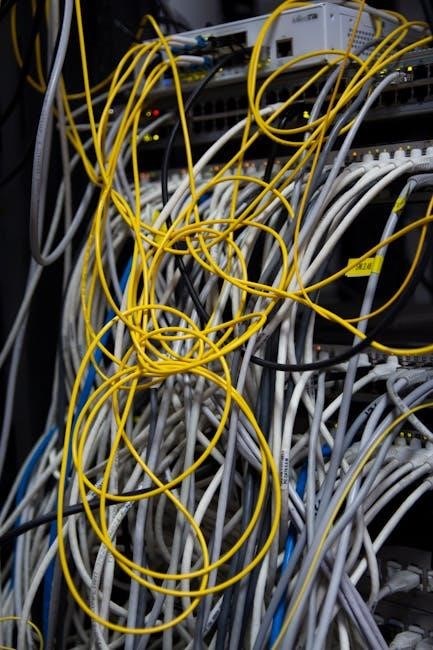Transfer switch wiring diagram manual provides comprehensive guide to installation and wiring‚ ensuring correct setup and functionality‚ using
relevant
diagrams and explanations for various models and applications always․
Understanding the Basics of Transfer Switches
Transfer switches are essential components in electrical systems‚ allowing for seamless switching between primary and backup power sources․ They are permanently hardwired to the service panel and mounted between the generator and the service panel․ The switch is wired to provide a power feed from the generator‚ enabling the transfer of power to the electrical system․ Understanding the basics of transfer switches is crucial for ensuring correct installation and functionality․ Transfer switches come in various types‚ including single-pole‚ double-pole‚ and three-pole switches‚ each with its own unique characteristics and applications․ By grasping the fundamental principles of transfer switches‚ individuals can make informed decisions about their electrical systems and ensure reliable and efficient power transfer․ This knowledge is vital for installing and operating transfer switches‚ and it is essential for maintaining electrical systems that rely on backup power sources․ Proper understanding of transfer switches is critical for safety and efficiency․
Importance of Manual Transfer Switch Wiring Diagrams
Manual transfer switch wiring diagrams provide essential guidance for installation‚ ensuring safety and efficiency‚ using
accurate
diagrams and explanations always and correctly․
Types of Manual Transfer Switches
Manual transfer switches come in various types‚ including single-pole‚ double-pole‚ and three-pole switches‚ each with its own unique characteristics and applications‚ using different
configurations
and designs to suit specific needs․
The single-pole switch is the most basic type‚ used for simple applications‚ while the double-pole and three-pole switches are more complex‚ used for more demanding installations‚ requiring
precise
wiring and setup․
These switches are designed to handle different amps and voltages‚ making them suitable for a wide range of uses‚ from residential to commercial and industrial applications‚ with
detailed
diagrams and explanations provided for each type․
Understanding the different types of manual transfer switches is crucial for selecting the right one for a particular installation‚ ensuring safe and efficient operation‚ and
preventing
potential hazards and downtime․
By choosing the correct type of switch‚ users can ensure reliable and efficient power transfer‚ minimizing the risk of
errors
and accidents‚ and guaranteeing optimal performance and longevity of the electrical system․
With the right manual transfer switch‚ users can enjoy peace of mind‚ knowing that their electrical system is safe‚ efficient‚ and reliable‚ with
clear
instructions and guidelines provided for installation and maintenance․

Components of a Transfer Switch Schematic Diagram
Transfer switch schematic diagrams include control panels and switches‚ using
relevant
symbols and notation to represent components and connections always correctly․
Control Panel and Switch Operation
The control panel is a crucial component of a transfer switch‚ providing vital information about the switch’s operation and displaying it via switches‚ knobs‚ and other indicators․ The control panel is typically mounted on the exterior or interior of a house‚ between the generator and the service panel․ It allows users to manually switch between the main power source and the backup generator․ The switch operation is designed to be simple and intuitive‚ with clear labeling and instructions․ The control panel may also include features such as voltage meters‚ frequency meters‚ and alarm systems to monitor the transfer switch’s performance․ By understanding the control panel and switch operation‚ users can ensure safe and efficient transfer of power between the main and backup sources․ The control panel is an essential part of the transfer switch wiring diagram manual‚ providing a comprehensive guide to the switch’s operation and installation․

Reliance Manual Transfer Switch Wiring Diagrams
Reliance manual transfer switch wiring diagrams provide detailed guides for 30‚ 40‚ 50‚ and 60-amp models‚ using
- relevant
information and explanations always correctly․
Availability of Diagrams for Different Amp Models
Diagrams for various amp models are readily available‚ including 30‚ 40‚ 50‚ and 60-amp models‚ providing users with access to relevant information for their specific transfer switch needs․
The diagrams are typically provided by the manufacturer and can be found in the user manual or on the company’s website․
Using these diagrams‚ users can ensure that their transfer switch is installed and wired correctly‚ regardless of the amp model․
This availability of diagrams helps to prevent errors and ensures that the transfer switch functions as intended․
By consulting the diagrams‚ users can verify that their transfer switch is compatible with their generator and electrical system․
The diagrams also provide a clear understanding of the wiring and installation process‚ making it easier for users to complete the setup․
Overall‚ the availability of diagrams for different amp models is an essential resource for users of transfer switches‚ providing them with the information they need to ensure safe and efficient operation․
The diagrams are an important tool for anyone installing or using a transfer switch‚ and they should be consulted carefully to ensure that the switch is used correctly․

Standard Specifications for Manual Transfer Switches
Manual transfer switches have standard specs‚ including general requirements and installation guidelines‚ outlined in documents‚ such as PDF and DOC files‚ for reference and compliance purposes always․
General Requirements and Installation Guidelines
The general requirements for manual transfer switches include compliance with relevant standards and regulations‚ such as those outlined in documents like the Manual Transfer Switch Standard Specs․
The installation guidelines typically cover aspects like mounting‚ wiring‚ and testing‚ to ensure safe and proper functioning of the transfer switch․
A
comprehensive guide
to these requirements and guidelines is essential for contractors and installers to ensure that the transfer switch is installed correctly and functions as intended․
The guidelines may also include information on the scope of work‚ like furnish‚ deliver‚ install‚ and test‚ as well as the requirements for the control panel and switch operation․
Additionally‚ the guidelines may outline the testing procedures to verify that the transfer switch is working correctly and providing reliable power transfer between the main power source and the backup generator․
Overall‚ following the general requirements and installation guidelines is crucial for ensuring the safe and efficient operation of manual transfer switches․
The guidelines are usually provided in a clear and concise manner‚ making it easier for installers to understand and follow them․
By following these guidelines‚ installers can ensure that the transfer switch is installed and functioning correctly‚ providing reliable power transfer and minimizing the risk of accidents or injuries․

on Transfer Switch Wiring Diagram Manual
The manual includes detailed diagrams and explanations‚ making it easier to understand the wiring process and ensure correct setup and functionality․
A
well-organized
manual is essential for safe and efficient operation of transfer switches‚ and it helps to minimize the risk of accidents or injuries․
The manual is typically revised and updated regularly‚ ensuring that it remains relevant and accurate․
By following the guidelines and instructions outlined in the manual‚ installers can ensure that the transfer switch is installed and functioning correctly‚ providing reliable power transfer between the main power source and the backup generator․
Overall‚ a transfer switch wiring diagram manual is a crucial tool for anyone involved in the installation and maintenance of manual transfer switches‚ and it plays a vital role in ensuring the safe and efficient operation of these devices․
The manual is an important resource that helps to ensure compliance with relevant standards and regulations․
